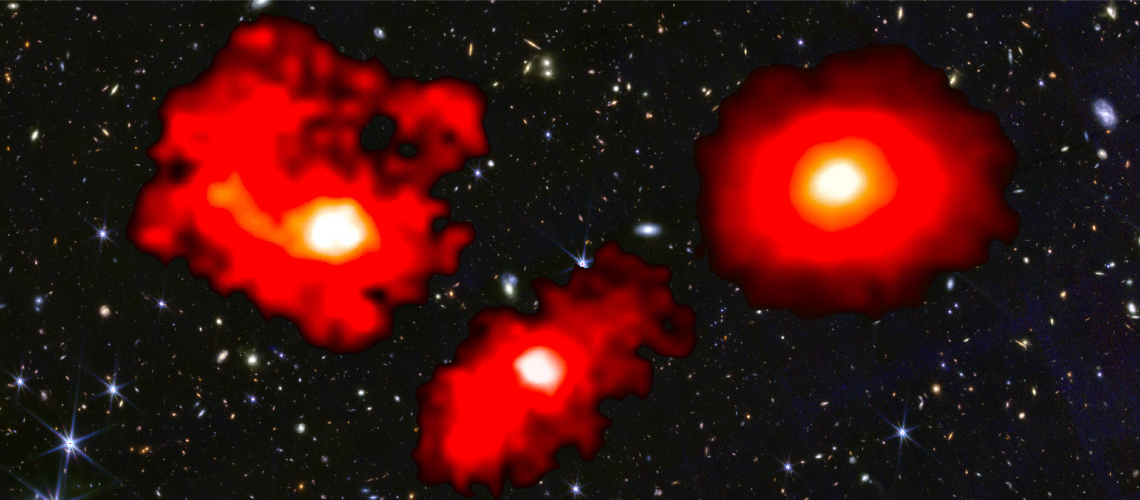Follow us on Google News (click on ☆)
This surprising discovery was made possible by the James Webb Space Telescope's FRESCO program, which uses the NIRCam/grism spectrograph to precisely measure the distances and stellar masses of galaxies.

The three red monsters are extremely massive and dusty galaxies in the first billion years after the Big Bang.
© NASA/CSA/ESA, M. Xiao & P. A. Oesch (University of Geneva), G. Brammer (Niels Bohr Institute), Dawn JWST Archive
The results indicate that star formation in the early Universe was far more efficient than previously thought. They challenge existing galaxy formation models. The study is published in Nature.
According to the prevailing theoretical model favored by scientists, galaxies gradually form within vast halos of dark matter. These dark matter halos capture gas (atoms and molecules) to create gravitationally bound structures. Generally, only 20% of this gas is converted into stars in galaxies.
However, new discoveries by an international team led by UNIGE and using NASA's James Webb Space Telescope (JWST) challenge this perspective. They reveal that massive galaxies in the early Universe might have been much more efficient at star formation than their later counterparts and developed far more quickly than previously assumed.
Discovery of the "red monsters"
The unprecedented capabilities of the JWST enabled astronomers to study galaxies in the very distant and thus young Universe, providing insights into both massive galaxies and dust-obscured galaxies. By analyzing the galaxies in the FRESCO study, scientists observed that most of the sources matched existing theoretical models. However, they also discovered three surprisingly massive galaxies, whose stellar mass is comparable to that of the current Milky Way.
These galaxies form stars almost twice as efficiently as their lower-mass counterparts and older galaxies. Due to their high dust content, which gives them a distinctive red appearance in JWST images, they were nicknamed the "three red monsters."
"Our results are redefining our understanding of galaxy formation in the early Universe," says Mengyuan Xiao, lead author of the new study and a postdoctoral researcher in the Department of Astronomy at the UNIGE Faculty of Science. David Elbaz, research director at CEA Paris-Saclay, adds: "The massive properties of these 'red monsters' had barely been determined before the JWST, as they are optically invisible due to dust-induced attenuation."
A major step forward in galaxy observation
The international team developed a new program with the JWST to systematically analyze a complete sample of emission-line galaxies from the first billion years of cosmic history. This approach enabled the team to obtain precise distance estimates and reliable stellar mass measurements for the entire galaxy sample.
"Our findings highlight the remarkable power of NIRCam/grism spectroscopy," explains Pascal Oesch, associate professor in the Department of Astronomy at the UNIGE Faculty of Science and the principal investigator for this observation program. "The instrument on board the space telescope allows us to identify and study the growth of galaxies over time and gain a clearer picture of how stellar mass accumulates throughout cosmic history."
Galaxies too numerous and too massive in the early Universe
Although these findings are not inconsistent with the standard cosmological model, they raise new questions for galaxy formation theories, particularly around the problem of "too many and too massive" galaxies appearing early in the Universe.
Current models may need to account for unique processes that allowed some early massive galaxies to achieve such efficient star formation and thus form very quickly, very early in the Universe. Future observations by the JWST and the Atacama Large Millimeter Array (ALMA) will provide further insights into these ultra-massive "red monsters" and reveal larger samples of such sources.
"These findings show that galaxies in the early Universe might have formed stars with an unexpected level of efficiency. As we study these galaxies more deeply, they will yield new insights into the conditions that shaped the early epochs of the Universe. The 'red monsters' are just the beginning of a new era in our exploration of the early Universe," concludes Dr. Mengyuan Xiao.